For off-grid tiny living, Starlink offers reliable, high-speed internet with broad coverage and stable performance in remote areas, but it needs a dish setup and space. 5G hotspots are easy to install, portable, and ideal for quick, short-term use, especially in areas near towers. While Starlink suits long-term, off-grid needs, 5G works well with nearby infrastructure. To find the best fit for your lifestyle and environment, explore these options further.
Key Takeaways
- Starlink provides reliable, high-speed internet in remote areas but requires larger equipment and fixed installation, less ideal for frequent mobility.
- 5G hotspots are portable, quick to set up, and suitable for tiny living, but depend on nearby cell towers and may have limited rural coverage.
- In off-grid environments, Starlink’s satellite coverage ensures connectivity where cellular networks are unavailable or weak.
- 5G offers lower latency suitable for real-time activities, but performance can vary with terrain and tower proximity.
- Cost and power needs differ: Starlink has higher upfront hardware costs and steady power requirements, while 5G hotspots are more affordable and portable.
Coverage and Geographic Flexibility
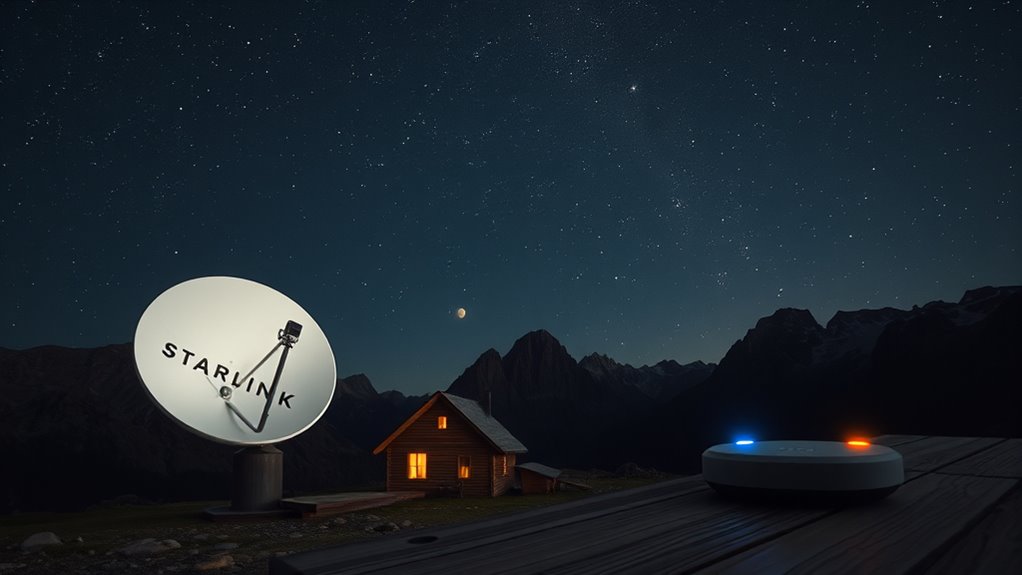
When it comes to off-grid internet options, coverage and geographic flexibility are key considerations. Starlink offers nearly global coverage, needing only a clear sky to connect. It’s ideal for remote or rural areas where traditional broadband or cell towers are scarce. Unlike 5G, which depends on dense networks of cell towers mainly found in urban settings, Starlink uses satellites, eliminating the need for physical infrastructure. This makes it perfect for remote living, travel, or mobile lifestyles. You can access the internet from anywhere with a clear view of the sky, whether at sea or in the wilderness. While 5G excels in cities, Starlink bridges the connectivity gap in rural environments. Combining both can provide maximum flexibility, adapting to different locations and needs seamlessly. Satellite internet’s broad coverage also makes it a reliable choice for emergency situations when terrestrial networks are compromised. Additionally, the maintenance and setup of satellite systems are straightforward, making them accessible for off-grid users.
Speed and Performance

Your internet speed and performance can vary greatly depending on your setup and location. Factors like weather, network congestion, and signal strength influence how fast and reliable your connection is. Understanding these differences helps you choose the best off-grid option for your needs. Coverage area and technology type play a significant role in determining consistent performance, especially in remote or rural locations. Additionally, angel number soulmate insights can offer guidance when selecting the most suitable technology for your personal or spiritual needs.
Speed Variability Factors
Speed and performance of off-grid internet can fluctuate due to various environmental, technological, and usage factors. For Starlink, clear line-of-sight is essential; obstructions like trees or buildings can cause speed drops or outages. Weather conditions, such as rain or heavy clouds, can weaken satellite signals, reducing speeds. As more users join, network congestion during peak times can slow down Starlink’s performance, especially in dense areas. Starlink satellites orbit closer and denser, offering higher throughput and speeds, which can also be affected by the number of connected users. For 5G hotspots, coverage depends on tower density; urban areas typically have consistent high speeds, while rural zones may lack coverage. High-frequency 5G bands offer faster speeds but shorter range, while lower bands provide broader coverage with slower speeds. Physical terrain and device capacity also influence speed variability, impacting your internet experience across both options. Additionally, smart device usage and network security settings can further impact connection stability and speed.
Latency Differences Explained
Latency plays a crucial role in determining the responsiveness of off-grid internet options like Starlink and 5G. Starlink’s average latency ranges from 37 ms to 70 ms, influenced by satellite handoffs, while 5G’s latency is typically between 1 ms and 45 ms, depending on tower proximity. Lower latency in 5G makes it better for real-time activities like video calls and gaming.
| Feature | Starlink | 5G |
|---|---|---|
| Average Latency | 37–70 ms | 1–45 ms |
| Impact of Environment | Consistent in rural/urban | Varies with tower location |
| Obstructions | Needs clear sky | Less affected by obstacles |
Rural Performance Comparison
In rural areas, the performance of off-grid internet options varies considerably, with Starlink generally providing higher speeds and greater reliability than 5G hotspots. Starlink typically offers speeds between 50-250 Mbps, often maintaining 100-200 Mbps even with obstructions, thanks to satellite technology that bypasses traditional infrastructure. It’s more consistent across different environments, providing reliable service despite weak signals or obstacles. Conversely, 5G hotspots can deliver speeds from 100-300 Mbps in strong coverage areas but often struggle in rural zones, sometimes dropping below 10 Mbps. They depend on proximity to cell towers and are less reliable outside prime coverage zones. While 5G devices are more portable and easier to set up, Starlink’s higher upfront costs are balanced by its broader coverage and unlimited data options. Starlink speeds remain more stable in challenging environments, making it the preferable choice for long-term rural connectivity. Additionally, advancements in AI security are improving the reliability and security of satellite and cellular networks, ensuring safer and more resilient off-grid internet access.
Setup and Portability
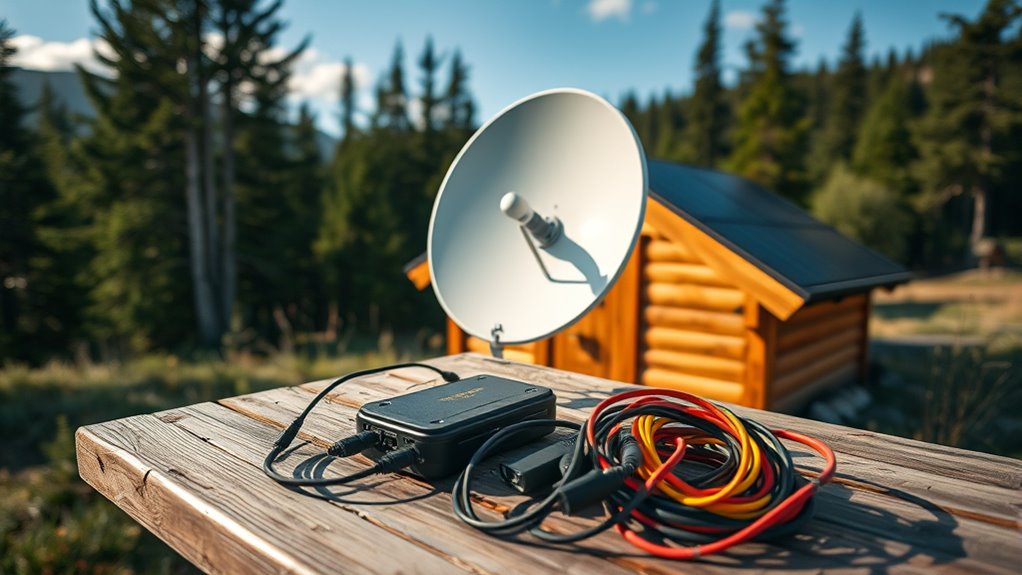
Setting up off-grid internet depends on the device you choose, with some requiring more effort than others. Starlink needs a clear sky and stable placement, while 5G hotspots are ready to go instantly. Your choice impacts how easily you can move and how much space and hardware you’ll need. Starlink’s satellite dish requires proper alignment and a stable, unobstructed view of the sky for optimal performance. Historically, the development of satellite and cellular technologies has been influenced by early agricultural practices, which emphasized sustainability and resource management.
Ease of Deployment
Deploying off-grid internet options varies considerably in ease, with 5G hotspots offering a straightforward, plug-and-play experience that requires minimal setup, while Starlink involves more complex installation steps. With 5G hotspots, you simply power on the device, connect to your cellular plan, and go—no external hardware or alignment needed. Starlink, on the other hand, requires mounting a bulky dish with a clear sky view, aligning it properly, and connecting multiple components, which takes time and technical understanding. The table below highlights key differences:
| Aspect | 5G Hotspot | Starlink |
|---|---|---|
| Setup Complexity | Minimal, plug-and-play | Moderate, mounting and alignment |
| Portability | High, pocket-sized | Limited, bulky hardware |
| Power & Deployment | Low power, indoor use | Higher power, outdoor setup |
Additionally, 5G hotspots benefit from wireless connectivity, making them adaptable to various environments without extensive infrastructure.
Mobility and Convenience
Starlink’s bulky dish and need for precise alignment make it less convenient to move frequently, especially compared to compact, handheld 5G hotspots. Moving the dish requires effort to reorient and find a clear sky, which isn’t ideal for frequent relocations. Power sources can also limit off-grid mobility, since Starlink needs a reliable supply. In contrast, 5G hotspots are small, lightweight, and ready to use in seconds—no realignment needed. They’re battery or USB powered, making them perfect for on-the-go use. Plus, they connect instantly wherever cellular coverage exists. Cellular connectivity depends on proximity to cell towers; range limitations affect performance. Portable and lightweight, fitting in pockets or small bags. Plug-and-play setup with no reorientation. Instant connection upon powering on. No complex power requirements, and their mobility and convenience make them ideal for tiny living setups.
Physical Setup Requirements
The physical setup of a Starlink system involves several components that influence how portable and practical it is for off-grid use. The kit includes a dish, router, power supply, and cables, with options varying by model. The dish has a built-in kickstand or can be mounted permanently, requiring drilling surfaces or using temporary bases. Cabling is proprietary and typically around 50 ft, with longer cables available. Power supplies vary, with some integrated into the router, others separate. Larger dishes demand more space and handle more fragile, heavier hardware, making frequent relocation cumbersome. Unlike 5G hotspots, which are compact, battery-powered, and plug-and-play, Starlink’s setup often needs a dedicated space and careful handling. Consider the table below for key differences:
| Component | Starlink | 5G Hotspot | Notes |
|---|---|---|---|
| Size | Larger, bulkier | Pocket-sized | Portability differs |
| Mounting | Permanent or temporary bases | No mounting required | Ease of setup |
| Power | Separate or integrated supplies | Battery or plug-in | Power flexibility |
| Cables | Proprietary, about 50 ft, weatherproof | None or minimal | Routing complexity |
| Setup Time | Moderate, some initial alignment | Instant, plug-and-play | Physical handling |
Cost and Affordability
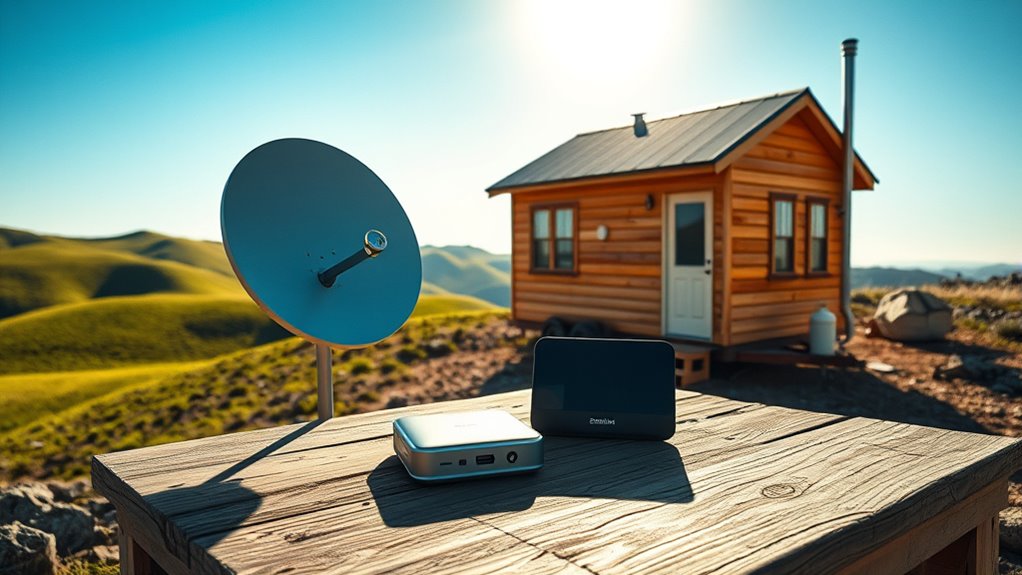
When considering off-grid internet options, cost and affordability are key factors that can substantially influence your choice. Starlink plans start at $80/month, with higher tiers reaching $165 for unlimited data. In contrast, 5G hotspots like T-Mobile range from $35 to $70 monthly. Starlink requires additional upfront costs for hardware and setup, which are refundable, while 5G device costs are usually lower. Keep in mind, extra data on Starlink can cost $2 per GB, adding up quickly for heavy users. Curiosity about different technologies can help you make more informed decisions tailored to your needs.
Reliability and Use Cases in Tiny Living
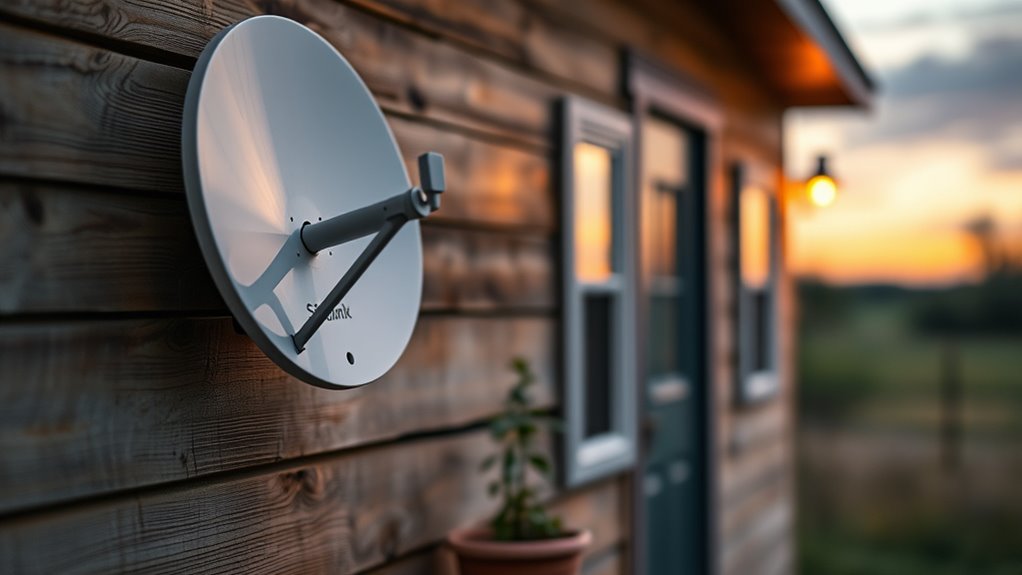
Reliability in tiny living environments depends heavily on the network technology you choose, as each option has distinct strengths and limitations. Starlink offers consistent high-speed internet globally, relying on low-Earth orbit satellites for stable connections, even during travel through remote areas. It’s ideal for high-bandwidth activities, long-term setups, and off-grid locations. In contrast, 5G hotspots depend on proximity to cell towers, making them less reliable in rural or isolated areas. Speeds can be high in urban zones but drop with distance, and latency varies markedly. They’re better suited for urban or short-term use, casual browsing, and situations where quick setup and portability matter. Overall, Starlink provides more dependable, versatile connectivity for those living off-grid or in remote regions. Additionally, understanding the Law of Attraction principles can help maintain a positive mindset when adapting to new off-grid technologies and challenges.
Technical and Environmental Considerations
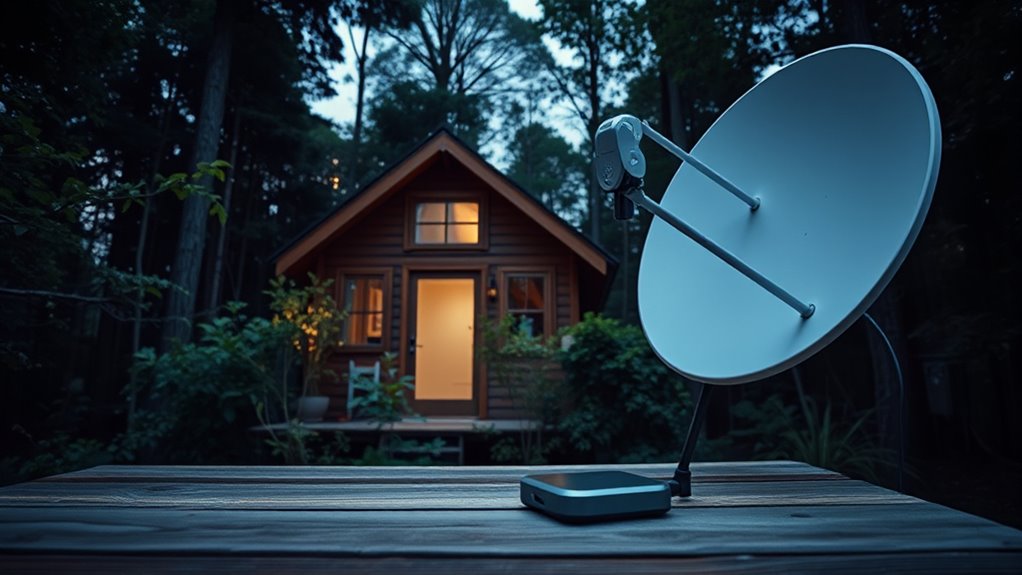
Choosing the right off-grid internet solution involves understanding both the technical aspects and environmental impacts of satellite and terrestrial technologies. Starlink’s nearly 7,000 satellites operate at 340–614 km, with plans to refresh every five years, increasing reentry debris and aluminum oxide pollution. These satellites are heavier and larger than earlier models, requiring significant manufacturing and launch resources. In contrast, 5G hotspots depend on terrestrial towers, which need dense infrastructure and can strain local environments. Additionally, the environmental footprint of satellite deployment and maintenance raises concerns about long-term sustainability.
Choosing between satellite and terrestrial internet involves weighing environmental impacts and infrastructure needs.
- Starlink satellites contribute to atmospheric pollution and light interference
- Reentry debris poses minimal but present environmental risks
- 5G relies on land-based infrastructure, with its own ecological footprint
- Both options involve resource use, trade-offs, and environmental considerations for tiny living setups
Combining Technologies for Optimal Connectivity

Combining satellite and terrestrial technologies creates a robust off-grid internet setup that guarantees continuous connectivity. You can set up automatic failover so if one network weakens or goes offline, the other takes over seamlessly. Using routers like Peplink that handle multiple WAN inputs allows for quick switching or bonding between Starlink and 5G, ensuring reliable access. This setup minimizes downtime, which is essential for remote living where staying connected is fundamental. Additionally, network management tools enable you to monitor signals and adjust priorities remotely, optimizing bandwidth use. Pairing Starlink’s high-speed download with 5G’s balanced upload speeds boosts overall performance. External antennas for 5G improve reception, while bonding networks increases throughput and reduces latency. Starlink’s high-speed capabilities this integration offers a flexible, resilient, and efficient internet solution for tiny living off the grid.
Frequently Asked Questions
Can I Use Starlink and 5G Simultaneously for Seamless Internet?
Yes, you can use Starlink and 5G simultaneously for seamless internet. You’ll need channel bonding software like Speedify or multi-WAN routers that support combining these connections. This setup distributes your online traffic intelligently, providing faster, more reliable, and stable connectivity. It’s especially useful in remote or off-grid areas, as it leverages the strengths of both satellite and cellular networks, ensuring you stay connected even if one link drops.
How Weather-Resistant Are Starlink Dishes Compared to 5G Hotspots?
You wonder how weather-resistant Starlink dishes compare to 5G hotspots. Starlink dishes excel with high wind resistance, rated up to 280 kph, and water protection, especially the High-Performance models with IP56 ratings. In contrast, 5G hotspots vary widely, often needing extra enclosures for weatherproofing. While Starlink’s design prioritizes durability, 5G devices rely more on external cases and are more vulnerable to severe weather conditions.
What Are the Best Power Solutions for Off-Grid Starlink Setups?
You need reliable power solutions for your off-grid Starlink setup. Portable power stations like EcoFlow DELTA 3 Pro provide ample capacity, supporting long-term use and can be recharged with solar panels for sustainability. Solar arrays should generate enough energy to cover daily needs, especially during cloudy days. To keep your internet stable, choose systems with capacity buffers, monitor power consumption, and consider backup options like additional batteries or generators for extreme conditions.
Do 5G Hotspots Support VPNS and Advanced Networking Features?
You might think 5G hotspots can’t handle advanced networking, but many do support VPNs and top-tier security features. They often include enterprise-grade VPN protocols like IPSEC and SSL, plus WPA3 encryption. You can connect multiple devices, use wired ports, and manage networks remotely. While VPN performance can vary, with proper setup, these hotspots offer robust security and flexible connectivity, making them suitable for secure, off-grid use.
Is Satellite Dish Installation Permitted in All Tiny Living Locations?
You wonder if satellite dish installation is allowed in all tiny living spaces. Federal rules give you the right to install a dish up to one meter, but restrictions depend on your location. You can usually install inside your home or on private areas like patios. However, building codes, HOA rules, or property management might limit placement, especially on shared or communal spaces. Always check local ordinances and obtain necessary permits to stay compliant.
Conclusion
In the quest for off-grid internet mastery, choosing between Starlink and 5G hotspots might feel like selecting the crown jewel for your tiny living kingdom. Whichever you pick, you’ll gain access to a connectivity so powerful, it could rival the internet kingdoms of old! Embrace the ultimate freedom, seamless performance, and unmatched flexibility—your tiny home will become a digital fortress, unstoppable and boundless. The future of off-grid living is here, and it’s more spectacular than you ever imagined.
I’m Theodore, and I love tiny houses. In fact, I’m the author of Tiny House 43, a book about tiny houses that are also tree houses. I think they’re magical places where imaginations can run wild and adventures are just waiting to happen.
While tree houses are often associated with childhood, they can be the perfect adult retreat. They offer a cozy space to relax and unwind, surrounded by nature. And since they’re typically built on stilts or raised platforms, they offer stunning views that traditional homes simply can’t match.
If you’re looking for a unique and romantic getaway, a tree house tiny house might just be the perfect option.
















